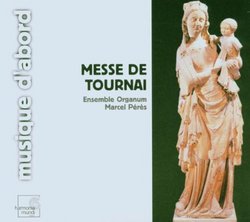| All Artists: Josep Cabre, Marcel Peres, Gregorian Chant, Flemish Anonymous, Plainchant Chant, Josep Benet, Patrick Aubailly, Frederic Richard Title: Messe de Tournai Members Wishing: 1 Total Copies: 0 Label: Harmonia Mundi Fr. Original Release Date: 1/1/2006 Re-Release Date: 8/8/2006 Album Type: Import Genre: Classical Styles: Opera & Classical Vocal, Historical Periods, Early Music Number of Discs: 1 SwapaCD Credits: 1 UPC: 794881802326 |
Search - Josep Cabre, Marcel Peres, Gregorian Chant :: Messe de Tournai
 | Josep Cabre, Marcel Peres, Gregorian Chant Messe de Tournai Genre: Classical
|
Larger Image |
CD Details |
CD ReviewsIn the Beginning was the Chant... Giordano Bruno | Wherever I am, I am. | 07/13/2008 (5 out of 5 stars) "Modern people imagine that spiritual seekers, usually adult, have always turned away from the world to seek individual realization/redemption in the monastic life, in solitude and silence and self-discipline. This may be the case now, and it may have been so since the late Renaissance. In the heyday of monasticism in Europe, however -- in the 12th-14th Centuries when the great monasteries were the capitals of European science, agriculture, technology, and finance as well as learning -- the monastic life was not about individual salvation. Built sometimes in "waste" lands, the great monasteries were never as isolated from society as we may imagine. They depended fully on their surrounding societies for donations of support in land and money, for recruitment of personnel via oblation, for markets for their products, for protection from violence, and for legal and ecclesiastical services. In turn, the societies around were dependent on the monasteries for services, and not just rites and burials; the singing monks had the specific role in society of seeking God's grace for everyone, of interceding with God on behalf of those who specialized in other tasks. Above all, the monks were communitarian; they ate together, slept in close proximity, did their little routines together, and above all SANG together, for hours of every living day. Fully tonsured monks sang the entire book of psalms, with seasonally specific plainchants, at the liturgical Hours; they all sang, and they mostly sang in unison from memory. Thus it seems almost inevitable that their greatest cultural invention was polyphonic music, and it was a unique invention. No other society in the world, even including secular Medieval society, has ever independently invented polyphony. Lots of cultures have heterophonic music, but polyphony is something special, when two or more voices sing/play melodic material at the same time though different, and when those voices mesh together in mathematically proportionate harmonies and rhythms. By the 15th Century, Europe was 1000 years ahead of any other society in musical sophistication; one element of that sophistication was precise mensural notation, which developed in tandem with polyphony, as a necessary support.
It takes enormous self-abnegation, enormous inter-communion, to sing polyphony. It's the least individual act conceivable. The Messe de Tournai is considered the oldest surviving complete polyphonic mass. It was re-discovered in a well-worn chant book in Tournai Cathedral in 1862, and has been dated by scholars to the second quarter of the 14th C. The parchment on which it was written shows the kind of wear that came from actual use for liturgical occasions. The chant material in the manuscript is chiefly Marian, so the mass was most likely performed in a side chapel of the cathedral devoted to the Cult of the Virgin. It's unlikely that the mass was composed by a single person; rather it consists of stratifications of overlay, tropes (extensions) of pre-existing musical material, and standard-practice harmonizations based on habits of improvization. The separate movement of the mass per se are very different in structure and style, with the Kyrie seeming the most archaic and the Ita Missa Est (which later generations omitted from polyphonic settings) seeming the most modern. This mass stands at the very base of all European and American music for the rest of the millennium. It's curious to think that it will sound remarkably "foreign" to most modern first-time listeners. More than half of the music on this CD is not the fixed elements of the mass at all, but rather introits, graduels, offertoire, communion, etc. - the appropriate chants of the liturgical calendar. Thus the mass is embedded in and highlighted by plainchant, solo and unison singing. The communion chant performed here includes singing by the choir against long drone-like notes sung by other members of the choir; such singing over a "tenor" has to be understood as the very first step toward real polyphony. There are, of course, no instruments. Ensemble Organum is whomever Marcel Peres chooses to hire for a given performance. For this disk, Peres chose some extremely beautiful voices. The plainchant recorded here is among the finest I've ever heard, with perfect unity of expression and tuning. Peres has been accused of "orientalizing" the chant for exotic effect, but the accusation doesn't apply this time. I know this manuscript in facsimile very well, and I'd vouch for Peres's musical decisions being as "authentic" as any that could be made. The polyphonic singing is bold and exhuberant. All male voices, obviously: mixed choruses never sang Medieval liturgy. I imagine that improvised polyphony first sprang from human exhuberance and the "sinful" pride of the better singers in the monastery. Theologians might justify such exhuberance as serving God's secret purposes, but in fact at the beginning of the 14th C, Pope John XXII tried to suppress such innovations and extravagances. Luckily he failed. I love this performance! I should have reviewed it long ago. Better late than never, I suppose. In any case, I've written this review especially in dedication to Father James Egolf." |

 Track Listings (13) - Disc #1
Track Listings (13) - Disc #1